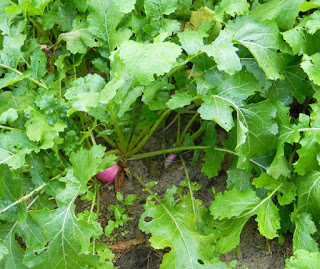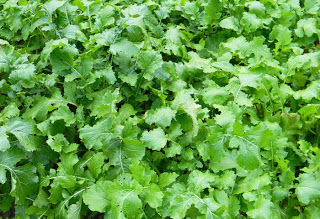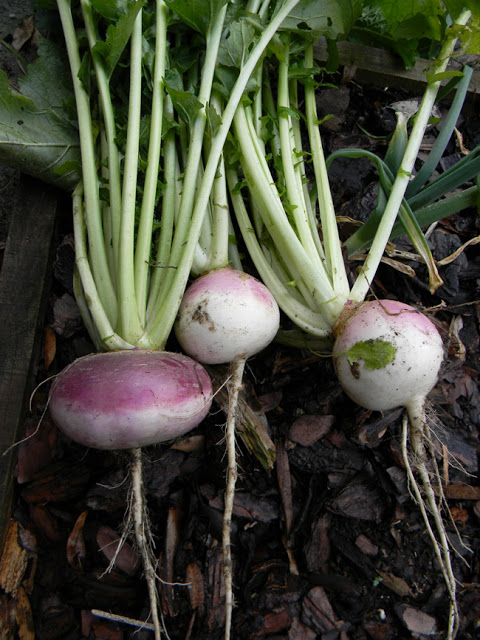 Turnips aren’t tantalizing. They’re downright pedestrian and often overlooked. I’ve grown them off and on for years, just because I like the way they grow. They used to be a complete mystery to me… and not at all something I enjoyed. Now I’m starting to like them, however. A few nights ago, Rachel sauteed some sliced turnips and pork loin – delicious. Peeling helps take away the bitterness, as does growing them quickly with good moisture.
Turnips aren’t tantalizing. They’re downright pedestrian and often overlooked. I’ve grown them off and on for years, just because I like the way they grow. They used to be a complete mystery to me… and not at all something I enjoyed. Now I’m starting to like them, however. A few nights ago, Rachel sauteed some sliced turnips and pork loin – delicious. Peeling helps take away the bitterness, as does growing them quickly with good moisture.
Reasons to grow turnips are multiple. Being yet another brassica (is it just me or is this like… “Brassica
Month” here at Florida Survival Gardening?), they’re quite good for you.
They’re also very easy to grow. They can be used to fatten hogs, they grow in the winter, they keep the ground covered, and they look pretty. Additionally, they store well, can be harvested over a decent amount of season, and the greens are a good vegetable all on their own. Speaking of that: some turnip varieties are grown solely for their leaves. If you’d like roots, too, make sure you didn’t buy that type of seed. The roots of the “leaf” varieties of turnips are woody and worthless.
On the down side, turnips are a bit bitter and they won’t be happy in the heat of summer. Don’t let that worry, you however – we’ve got tons of exciting summer crops we can grow here. Like cassava and snake beans! (There are plenty more I’m trying as well, including an edible variety of air potato… chaya… mountain papaya… chayote… West Indian Gherkins… anyhow, enough about that. Those are future posts. Back to turnips!)
 I plant my turnips in the late fall via broadcasting them over disturbed soil. I then rake and water them in. If you’re planting a small space, just plant the seeds at a nice spacing. I prefer chucking them, of course, but you may have other, more neurotic, preferences. They come up in a week or so and grow rapidly. I tend to be able to pull my first turnips in perhaps two months or so. The harvest doesn’t usually happen all at once. I usually get a few early monsters, followed by a stream of turnips hitting harvest size for weeks and weeks after that.
I plant my turnips in the late fall via broadcasting them over disturbed soil. I then rake and water them in. If you’re planting a small space, just plant the seeds at a nice spacing. I prefer chucking them, of course, but you may have other, more neurotic, preferences. They come up in a week or so and grow rapidly. I tend to be able to pull my first turnips in perhaps two months or so. The harvest doesn’t usually happen all at once. I usually get a few early monsters, followed by a stream of turnips hitting harvest size for weeks and weeks after that.
Go ahead. Plant some turnips. And if you don’t like them, feed them to your animals. Or saute them in garlic butter. That fixes everything.
(BTW, turnips get extra points for being a high-calorie winter staple. Even if they aren’t the most delicious thing in the world – they could keep you full during a crash.)
For more information on growing survival plants, check out my book Florida Survival Gardening.
3.5 Spuds
Name: Turnips
Latin Name: Brassica rapa
Type: Biennial
Nitrogen Fixer: No
Medicinal: No
Cold-hardy: Yes
Exposure: Full sun
Part Used: Leaves, roots
Propagation: Seed
Taste: Fair
Method of preparation: Boiled, roasted, steamed, stir-fried, pickled
Storability: Good. Leaves can be frozen, roots stored
Ease of growing: Easy
Nutrition: Very good
Recognizability: Moderate
Availability: High




10 comments
Nice … will they self-seed? Or how difficult it is to save the seeds for the next year?
It was great to meet you and Rick in person. I will probably be taking a few lambs to Summerfield next Thu (Jan 31) – is touring your (plural) paradise gardens an option? I'd love to see it and report back to the Cat Herders, so that when you guys will be making an appearance in these here parts you'll be a bona fide celebrities already :)
I'm an additional 45 minutes North of Rick, but you're certainly welcome to come by – that would be great. I'll hook you up with cuttings, seeds, etc. And if you've got extra meat or a spare piglet, I'll buy it. Just drop me an e-mail off the "contact" link at the top of my link list.
I'm not sure how they'll self-seed. This is my first year growing them seriously in Florida – sometimes the heat isn't kind to brassicas. I'll post again if they perennialize.
Indeed! Welcome to drop by and see the humble origins of my future agricultural empire.
rycamor@gmail.com
Thanks guys – I'll email you when I know for sure.
Bugs don't look to be a problem for your turnips. Do you do anything to prevent them ?
BTW – I am on a canal, so Iquanas are an issue with growing edible stuff where I am.
Bugs are only a minor problem. They chew a few holes here and there, but nothing big. The trick is to grow turnips over the winter here… if you're planting them in March, it's already way too late.
Iguanas are definitely a problem down south. Consider eating them. They're supposed to be tasty.
just in case if you want to try the pickeled turnips , here is the recipe : Ingredients
3 cups of water
1 cup white distilled vinegar
2 pounds of turnips, peeled and sliced into ½-inch thick wedges or into sticks
6 slices of a peeled beet
3 cloves of garlic, peeled and thinly sliced
⅓ cup of coarse ground kosher salt
1 bay leaf
Instructions
In a saucepan over medium-high heat, add 2 cups of water, the salt and the bay leaf, stirring until the salt is dissolved.
Remove the saucepan from heat and allow to cool until it reaches room temperature. Once cool, add the vinegar and the remaining 1 cup of water.
Cut the turnips into ½-inch wedges or into sticks. If you cut them into sticks, make them about the size of French fries. Place 1 slice of beet into each jar (this is what will give the turnips their pink color), then divide the turnips and garlic slices among the jars. Pour the salted brine over the turnips, making sure they are completely covered, top off with water if necessary.
Place the lids on the jars and let them sit at room temperature (in a cool place) for at least one week. Once done, they can be refrigerated until ready to serve. Pickles will keep for months when refrigerated.
My family used to cook turnip greens with the roots. Not too bad but I did not like the roots that much as a kid, but I did learn to eat them. I remember as a kid I would go into the garden and pull up a turnip, wipe off the root and eat it much like an apple. Sometimes I would use my pocketknife and scrape out some of the root to get a bite that did not require much chewing as a between meals snack. Finding a huckleberry bush in the woods was like hitting the jackpot. Always seemed to get hungry between meals.
Comments are closed.